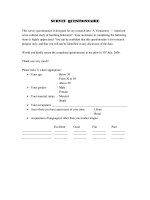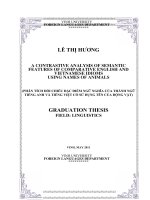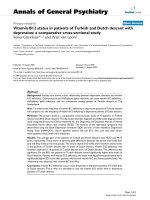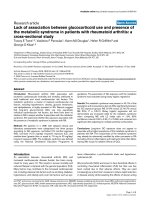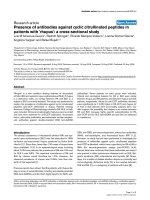Cross culutural study adressing form
Bạn đang xem bản rút gọn của tài liệu. Xem và tải ngay bản đầy đủ của tài liệu tại đây (259.97 KB, 30 trang )
UBND THÀNH PHỐ HẢI PHÒNG
TRƯỜNG ĐẠI HỌC HẢI PHÒNG
----------------
BÁO CÁO TỔNG KẾT
ĐỀ TÀI NGHIÊN CỨU KHOA HỌC CỦA SINH VIÊN
THAM GIA HỘI NGHỊ SINH VIÊN NCKH NĂM HỌC 2017 - 2018
A CROSS– CULTURAL STUDY OF ADDRESS FORMS IN GREETINGS
IN VIETNAMESE AND ENGLISH CULTURES
Thuộc Tiểu ban: NCKH khoa Ngoại Ngữ
Hải Phòng, tháng 5 năm 2018
TRƯỜNG ĐẠI HỌC HẢI PHÒNG
KHOA NGOẠI NGỮ
----------------
BÁO CÁO TỔNG KẾT
ĐỀ TÀI NGHIÊN CỨU KHOA HỌC CỦA SINH VIÊN
THAM GIA HỘI NGHỊ SINH VIÊN NCKH NĂM HỌC 2017 - 2018
A CROSS– CULTURAL STUDY OF ADDRESS FORMS IN GREETINGS
IN VIETNAMESE AND ENGLISH CULTURES
Thuộc Tiểu ban: NCKH khoa Ngoại Ngữ
Sinh viên thực hiện:
Ngô Hương Thảo (trưởng nhóm) Nữ
Nguyễn Thị Thanh Nga
Nữ
Phạm Thị Thanh
Nữ
Dương Thị Liên
Nữ
Trần Quang Minh B
Nam
Dân tộc: Kinh
Lớp, khoa: DHNNA3. K15
Năm thứ: 4/Số năm đào tạo: 4
Ngành học: Ngôn Ngữ Anh
Người hướng dẫn: Thạc sỹ Nguyễn Văn Phi
Hải Phòng, tháng 5 năm 2018
1
TABLE OF CONTENTS
LISTS OF TABLES, FIGURES....................................................................................2
PART A: INTRODUCTION.........................................................................................3
1.Rationale.................................................................................................................... 3
2. Aims of the study......................................................................................................4
3. Research questions....................................................................................................4
4. Scope of the study.....................................................................................................4
5. Method of the study..................................................................................................5
6. Organization of the study..........................................................................................5
PART B: DEVELOPMENT..........................................................................................6
Chapter 1. Theoretical background...............................................................................6
1.1. Language and culture.............................................................................................6
1.2. Communication and cross- culture communication...............................................7
Chapter 2: Addressing forms in greetings in Vietnamese and English..........................9
2.1. Addressing forms in greetings................................................................................9
2.3. Similarities and differences between Vietnamese and English informants in using
address forms..............................................................................................................13
2.4. Solutions for the cultural shock in greeting..........................................................24
PART C: CONCLUSION............................................................................................26
1. Recapitulation.........................................................................................................26
2. Suggestions for Further Studies..............................................................................26
REFERENCES...........................................................................................................28
2
LISTS OF TABLES
No.
Name
Table 1. Some addressing forms can be classified in terms of
1
Page
13
personal pronouns
Table 2: English addressing forms
14
Table 3: Vietnamese addressing forms
15
2
3
4
5
Table 4: Lineal relations
17-18
Table 5: Collateral relations
19-20
3
PART A: INTRODUCTION
1. Rationale
An emphasis on language as a communication system not only helps uncover
principles underlying social interactions, but also enables us to gain an access to ways
of thinking, belief systems, and world views of people from various cultural
backgrounds and thus enhances empathy and mutual understanding.
Understanding social conventions and attention to such concepts as politeness, and
face, which are important to members in a particular culture, will certainly enable us
to better comprehend the different ways of speaking by people from different cultures,
thus helping eliminate ethnic stereotypes and misunderstanding.
There have been so far plenty of researches on the field of politeness from various
perspectives. Yet, addressing forms in languages is still an area available for more
explorations. This research has chosen addressing forms as a potential subject. This
study is done not only to see the similarities and differences between the two cultures.
Another goal of this research is to give the awareness of the language learners about
the politeness of addressing forms in language, and to offer several suggestions in
using the appropriate forms of addressing.
Nevertheless, addressing forms is a very broad area, and within the limit of the study,
it is impossible to discuss all aspects of addressing forms in languages. As greetings is
the first step and it is also the most important in a conversation, so it requires the
speakers address accurately in order not to lose the face of the hearers. Compared with
English addressing system, Vietnamese addressing system is much more complicated
and diversified. A lot of foreigners find it very difficult and confusing to use
Vietnamese addressing forms. They regard accessing to Vietnamese addressing forms
as entering a maze. Even Vietnamese natives sometimes make mistakes for using
them. Therefore, Vietnamese addressing forms are said to be the most intricate
features in Vietnamese language for those who study Vietnamese. For any of those
purposes, the study promises to make itself meaningful, reliable and applicable to the
reality.
4
2. Aims of the study
For all the reasons mentioned above, the study contains the following different aims:
First of all, the study can help learners know more about the relation between
language and communication, culture and cross-cultural communication.
Secondly, we know that addressing forms is one of the important factors in
conversation, that is why this study can help learners and users of English know how
to address their interlocutors in a specific circumstance reasonably by using suitable
forms of address.
Lastly, cross-cultural study can give us a chance to find out the similarities and
differences in two countries through their cultures. Thus, this study supports the
fundamental knowledge of culture for Vietnamese users of English as students,
translators and learners in order to avoid cultural shocks or cross-cultural conflicts
involving the addressing forms in greetings in global communication.
3. Research questions
The study aims at answering the following questions:
- What are the greeting forms commonly used by English native speakers?
- What are the greeting forms commonly used by Vietnamese people?
- What are the differences of using addressing forms between Vietnamese and English
people?
4. Scope of the study
Addressing forms in communication is really an interesting issue, especially in crosscultural communication. There are many famous Vietnamese and foreign linguistics
and scholars having done researches on this linguistics field such as Brown and
Levinson (1987), Nguyen Quang (2001), etc. They have analyzed or compared almost
all aspects of this field. However, in cross-cultural communication we want to reach
communication goal and also take addressing forms into consideration. A person in
different relationship has different addressing forms. The speaker may be children,
5
parents, brothers in family or relatives. The speakers may be in high or low rank in
office, he/she may be older or younger compared interlocutors. Therefore, the study
enables learners to thoroughly understand addressing forms of the foreign language in
comparison with mother tongue. In this paper, we only deal with the characteristics of
the addressing forms in greetings in Vietnamese and English cultures and the
similarities and differences in using them in cross-cultural communication.
5. Method of the study
The first step was to search the library and the Internet for books, magazines and
articles on etiquettes, especially on addressing forms in greetings as well as previous
researches in the field.
The main method employed in this study is quantitative with material collecting and
analyzing.
6. Organization of the study
This research consists of three main parts. They are:
Part A is the introduction of the research paper in which the author presents the reason
for choosing the subject, the aims, the scope, the methods and the organization of the
study.
Part B is the development with two main chapters:
Chapter 1: Theoretical background
Chapter 2: Addressing forms in greetings of Vietnamese and English
Part C is the conclusion of the research paper, which summarizes the content
mentioned in part B and gives suggestions for further studies.
6
PART B: DEVELOPMENT
Chapter 1. Theoretical background
1.1. Language and culture
1.1.1. What is language?
According to Grigg (1993), “Language is the remarkable system that allows people to
communicate an unlimited combination of ideas using a highly structured stream of
sounds”. Language is the method of human communication, either spoken or written,
consisting of the use of words in an agreed way.
As we know that, a language is a system of sign for encoding and decoding
information. So, language is a system for communicating. Written language use
symbols to build words. The entire set of words is the language’s vocabulary. The
ways in which the words can be meaningfully combined is defined by the language’s
syntax and grammar. The actual meaning of words and combinations of words is
defined by the language’s semantics.
1.1.2. What is culture?
There are many various definitions. Culture would be defined by some as the art,
literature, and music of the people. It might include their architecture, history, religion
and their traditions. Other definitions would focus more on the customs or values of
the people. According to the UNESCO, “culture is a set of symbolic systems which
regulate the behavior and mutual communication of a plurality of people, establishing
them into particular and distinct community” (cited from Bui Tuan Anh, 2006).
1.1.3. The relation between language and culture
The connection between the human capacities for culture and language has been noted
as far back as classical antiquity. As language and culture are both in essence symbolic
systems, 20th century culture theorists, have applied the methods of analyzing
language developed in the science of linguistics to also analyze culture.
According to Levine and Adelman (1982), the relation between language and culture
is more complex than the coordinate title language and culture would suggest.
Language is, of course, an integral part of culture, defined simplistically as the totality
of beliefs and practices of a society.
7
1.2. Communication and cross- culture communication
1.2.1. Communication
1.2.1.1. Definition of communication
Communication is a process by which information is exchanged between individuals
through a common system of symbols, signs or behavior (Pride, 1985). It is clearly
seen that the way we communicate and the way we understand another person’s
communication is a result of our knowledge and past experiences. That means
communication can take place anywhere and is carried out by anybody. People
communicate as eye contact, facial expression, proximity, posture, gesture and verbal
language which are more used. In communication, interlocutors show their attitude,
relationship, mood, understanding, confusion and a whole range of other things and
convey a range of meaning in deferent culture, from insults to approval or even
attraction.
1.2.1.2. The role of addressing forms in communication
In communication, language plays an important role in conveying our thinking and
expressing our feeling and attitude in daily communication, meanwhile, addressing
forms belongs to the language system. That is why using address forms are
compulsory in communication. It allows participants to make turn taking, reveal
relationship, social status… Participants are both speaker and listeners involved
directly in conversation. And using forms of address, especially forms of address in
greetings can help us know interlocutors’ emotion, feeling as well as their knowledge,
culture, politeness and respect to each other. People who are involved in conversation
should depend on objects and other features of communicative situation such as age,
sex, family relationship, social status and power.
1.2.2. Cross- culture communication
The term “cross- culture” usually refers to the meeting of two cultures or two
languages across the political boundaries of nation states. They are predicated on the
equivalence of one nation- one culture- one language, and on the expectation that
“culture shock” may take place upon crossing national boundaries.
8
Cross- cultural communication: communication (verbal and nonverbal) between
people from different cultures; communication that is influenced by culture values,
attitude and behavior; the influence of culture on people’s reactions and responses to
each other (Nguyen Quang, 2012).
1.2.3. Cross- culture of addressing forms in greetings
According to Smith (1987), addressing forms in greeting is a phenomenon of
language. And as language is believed to be women into every fabric of every human
culture, it can be said that addressing forms in greetings is an element of culture.
The use of addressing forms in greeting by Vietnamese and English people is surely
affected by cultural features and cross- culture communication. To partially help avoid
the culture shock in this area, this research will discuss some main characteristics of
the way Vietnamese and English people using forms of address in greeting. It also can
help us know more about the way we can make a polite greeting by using the forms of
address of Vietnamese and English people.
9
Chapter 2: Addressing forms in greetings in Vietnamese and English
2.1. Addressing forms in greetings
2.1.1. Definition of greeting
In fact, no one can give an accurate definition of greeting. Here are some common
definitions of greeting in terms of anthropology, sociology, Wikipedia and Vietnamese
definition:
In “An Evaluation of Greeting Exchanges in Textbook and Real life setting”, two
linguistic Schegloff (2016) consider greeting as a speech event including of two parts
side by side serial and sequential such as Greeting- Greeting ( ex: A: Hello, B: Hi) or
Greeting- Request for information (ex: A: Hi, B: Have you finished your homework?).
According to Goffman (1971) - a sociolinguist prefers greeting as access rituals
consisting of two types: passing greeting and engaging greeting and constituted of
several interlinking behaviors: verbal linguistic form, term of address, non- verbal and
social context.
According to a definition on Wikipedia, greeting is an act of communication in which
human beings (as well as other members of the animal kingdom) intentionally make
their presence known to each other, to show attention to, and to suggest a type of
relationship or social status between individuals or groups of people coming in contact
with each other. Greetings can be expressed both audibly and physically, and often
involve a combination of the two. The major function of greeting is communication.
According to Ho Thi Loan, (2007) “Chào có nghĩa là nói ra hoặc ra hiệu bằng các cử
chỉ, tỏ lòng kính trọng, thái độ thân thiết” and Vietnamese proverb says “Lời chào cao
hơn mâm cỗ”
2.1.2. Addressing Forms in Greetings
10
Recently, Vietnam has obtained a very good relationships with many countries in the
world. It can be seen that knowing how to address each other in the polite ways in one
factor that not only contributes to the friendly atmosphere and the success of the
meeting but also helps to strengthen the partnership, integration and better the
understanding between two nations.
As mentioned in other parts of the research, politeness is one of the most important
aspects of human communication: human beings can only exist in peace together if
certain basic conversations of politeness are observed. Addressing forms in greetings
plays an important role in marking a successful conversation (Searl, 1965). Because it
can make a communication more effective as well as avoid the conflicts in
communication. Hence, it can be considered as a politeness phenomenon.
2.2. The Basic Forms of Address
In general, the customary forms of address in a language community can be
incorporated into a system by which a particular form is determined (Levinson, 1983).
This part of the research will present some basic forms of address used effectively in
the light of sociolinguistics and cross-cultural communication.
2.2.1. Personal Pronouns
In normal greetings of the conversations, personal pronouns are used widely to
distinguish the speaker “I” from the person or persons addressed “you” and other
participants “he, she, they”. Pronoun systems distinguish among these three roles, but
the number of personal pronouns in different languages is not the same. There are
twenty-two pronouns in Vietnamese and there are seven in English indicating 1st
person, 2nd person, 3rd person, singular and plural.
As we can see that, in both Vietnamese and English Language, the personal pronoun
“I” is used when the speaker refers to himself or herself to give personal opinions or
points of view, but the speaker can use the plural pronoun “we” when referring to a
group of people or to avoid personal responsibility in a refusal or disagreement. “We”
can also be used to show modesty when the speaker talks about a success or an
achievement. Thus, “we” can be used either “inclusively” for the speaker and some
11
third person together. Similarly, the pronoun “you” can be used for people addressed
plus some other people in greetings.
2.2.2. Titles
Normally, a title is used for the speaker as the 1st person in the greetings. It is
followed by the last name or full name of mainly for the addressee and the 2nd person
and someone else as the 3rd person. In Vietnam, a title may sometimes be used on its
own. For example: “Xin chào, ngài giáo sư”-“Hello, Professor”.
As mentioned above, the use of titles in English language and Vietnamese is not as
simple as it might appear.
2.2.3. Provisional Forms of Address
The term “provisional” forms of address means the forms that can be used to address
others just temporarily in certain contexts. In a very formal meeting, the person who
chairs the meeting can be called the chair, the chairman or chairwoman, even the
chairperson. Of these, the chairman is only used if the person is male and the
chairwoman is only used when the person is female, the other two may be used to
anyone. Madam Chairman now seems old fashioned. It seems difficult to decide how
to address the person who is in the chair. So it is frequently advisable to ask the one in
the chair how they wish to be addressed and what term they wish to use to describe
their own function in order to have a appropriateness in addressing forms in greetings
“Hello, chairman”, “Hello, chairwoman” or “Hello, chairperson” etc (Brown and
Levinson, 1987) . In Vietnam, it is quite possible to address a person by his or her
official position, for example, Minister “Bộ trưởng” and Director or Rector “Hiệu
Trưởng”.
2.2.4. Other Forms of Address
In very formal meetings, when the chairperson addresses everybody in the meeting he
or she often says “Ladies and Gentlemen”, at the opening of a meeting, when
postponing a discussion and closing a meeting in steading of the greetings. Besides
“everyone, someone, anyone, no one” when the speakers refers to people in the
meeting generally, they might use “those” and the equivalence of the plural personal
pronoun “they” to avoid “he” which may offend the female participants. How people
12
are addressed in a very formal meeting can be indicated in the procedure for a formal
meeting. The forms include pronouns, title plus last name, first name, the Chair, Mr.
Chairman, everyone, anyone, no one, someone and even avoidance of forms of
address which means not any forms of address is used. For example, “Hello” is used
in English language. However, Vietnamese always add an addressing term after the
verb of the utterance, namely “Xin chào ông/ bà”
13
The forms of address can be classified in terms of personal pronouns, title and other
provisional addressing terms.
Pronouns
Titles
Provisional
Other Forms
I, We
Mr.,Mrs., Miss,
Forms
Director
His/Your
You
Ms,Dr.,Prof.,Sir,
Rector
Excellency,
He, She, They
Madan
The Chairperson
Ladies and
Everyone,
Title + Full name
anyone, someone, Mr. Chairman
no one, those…
Gentlemen,
full
name…
Table 1. Some addressing forms can be classified in terms of personal
pronouns
2.3. Similarities and differences between Vietnamese and English informants in using
address forms.
2.3.1. Definition of addressing forms
According to Luong: “Both the use and the meanings of Vietnamese person-referring
forms are saliently and inextricably linked to the power, solidarity, and formality
dimensions in the relations among the addressor, addressee, as well as the referred
parties.” (As cited in Luong, 1990, p.5). The appropriate choice of Vietnamese
addressing forms to utilize involve and consideration a wide range of sociolinguistic
factors, such as age, sex, social status, relationship( blood, intimate or distant),
attitudes ( respectful or arrogant), feelings of the speakers and addressee as well as the
formality of the communication context. English addressing forms, unlike Vietnamese
ones, content “prefabricated units”, such as I, we and you, in communication. It means
that these units can be used in any context and with everyone. English addressing
14
forms don’t include in themselves any information of sociolinguistic factors or the
formality of the communication.
2.3.2.Contrasting of English and Vietnamese addressing form
2.3.3.1. Personal pronoun
Personal pronoun is a word used instead of a noun that represents a specific person. Its
use depends on number (singular, pural), person (first, second, third), gender (male,
female, neutral), and case (subject, object). These two following tables will illustrate
the difference between English and Vietnamese personal pronoun.
English personal pronoun
singular
subject
Plural
object
reflexive
subject
object
Reflexive
me
myself
we
us
Ourselves
you
yourself
you
you
Yourselves
third masculine he
him
himself
they
them
Themselves
feminine
she
her
Herself
neuter
it
it
Itself
first
second
you
Table 2: English addressing forms
Persons
Number
15
P1
(addressor) P2
(English "I/we")
tôi
tao
ta
tớ
mình
/
Chúng tôi
Chúng tao
ta/chúng ta
(addressee) P3 (third person
(English "you")
referent) (English
"he, she, it/they")
nó, hắn, y
/
Singular
mày, mi
mi
cậu, bạn, trò
bạn
mình
Các bạn
Chúng nó, chúng, Plural
Chúng
mày, họ,
bây,chúng bây ,tụi
mày, tụi bây
Chúng tớ
Các cậu
mình, chúng mình, Các bạn
tụi mình
Table 3: Vietnamese addressing forms
As these two tables can be seen, Vietnamese and English personal pronoun must be in
agreement with correct gender and number of people being described. However,
Vietnamese has more forms of personal pronoun than English does. There are five
common pronouns for the first person singular reference and the corresponding plural
forms for five singular forms by adding “chúng” to them. “Mình” and “ta: can be used
in both plural and singular form. In the second person reference, there exist three
singular and 3 corresponding plural forms. The third person reference includes four
commonly used pronouns in the singular form and three in plural. In English personal
pronoun, there are only two forms for the first person: I (singular) and we (plural).
You are used for both the second singular and plural person. The third person includes
three singular forms, such as he, she and it; and only one plural form - they. In the first
and second person, they exist in to neutral dyadic pairs (I - You and We - You) which
are regarded as prefabricated units because they are used to communicate in any
context and with everyone, not containing any information of gender, age or social
and family relationship as well as the formality of communication. The third person is
16
only used to refer to the difference of gender but age between the speakers and
listeners in any dimensions of the communication.
As for grammar, Vietnamese personal pronoun, unlike English personal pronoun, does
not have transformation from subjective form to objective form so Vietnamese one
can be used as both subject and object in sentences. In English personal pronoun,
there is a clear distinction between subjective and objective forms of addressing. Each
subjective form also has its own relevant objective form.
Eg: Cô ấy yêu tôi
She loves me
Tôi yêu cô ấy
I love her
In Vietnamese personal pronoun: the subjects are the same with the objects: cô ấy, tôi.
In English personal pronoun: “she” has the objective form “her”, “I” have the
objective form “me”.
2.3.2.2. Kinship Term
Kinship terms, according to E. R. Leach , are “category words by means of which an
individual is taught to recognize the significant groupings in the social structure into
which he is born” (as cited in Leach,1958, p. 143). All languages in the word have
kinship terms, which are clearly highlighted in addressing forms of a language.
Without exception, all kinship terms make use of such factors as age, sex, generation,
blood and marriage in their society. Both English and Vietnamese languages also have
their own kinship terms, which cannot be translated into each other equivalently.
There are both similarities and differences between English and Vietnamese kinship
terms through the following table 3 and table 4:
Relation to ego
English term
Vietnamese term
17
Reciprocal
grandfather
Ông nội
Ông ngoại
Cháu
cháu
grandmother
Bà nội
Bà ngoại
Cháu
cháu
Father
father
Ba, cha, tía, bố
con
Mother
mother
Mẹ, má, u, bầm
con
elder brother
brother
Anh trai
Em trai
em
sister
Chi gái
Em gái
Cha, má, bố, mẹ…
Son
son
Con trai
Cha, má, bố, mẹ…
Daughter
daughter
Con gái
Cha, má, bố, mẹ…
son’s son
grandson
Cháu trai ( cháu Ông bà nội, ông bà
paternal
grandfather
maternal
grandfather
paternal
grandmother
maternal
grandmother
younger brother
elder sister
younger sister
nội
daughter’s son
or
cháu ngoại
ngoại)
son’s daughter
granddaughter
Cháu gái ( cháu Ông bà nội, ông bà
daughter’s
nội
daughter
ngoại)
or
cháu ngoại
Table 4: Lineal relations
Relation to ego
father’s elder brother
English term
uncle
Vietnamese
Reciprocal
term
Vietnamese
Bác
cháu
18
father’s younger brother
Chú
mother’selder brother
Bác
mother’s younger brother
Cậu
father’s elder/ younger sister
aunt
Bác, cô
cháu
mother’s elder/ younger sister
Bác, dì
father’s brother’s son (elder / cousin
Anh em trai Em, anh, chi
younger)
bà con
father’s sister’s son (elder /
Anh em trai
younger)
họ hàng
mother’s brother’s son(elder /
younger)
mother’s sister’s son(elder /
Chị em gái
younger)
họ hàng
father’s brother’s daughter(elder
Chị em gái
/ younger)
bà con
father’s sister’s daughter(elder /
younger)
mother’ brother’s daughter(elder
/ younger)
mother’s
daughter(elder / younger)
brother’s son
sister’s son
wife’s sibling’s son
husband’s sibling’s son
sister’s
nephew
Cháu trai
Chú, cô
19
brother’s daughter
niece
Cháugái
Cậu, dì
aunt
Bác
cháu
sister’s daughter
wife’s sibling’s daughter
husband’s sibling’s daughter
mother’selder brother ‘ wife
mother’s younger brother’ wife
Mợ
father’s elder brother’ wife
aunt
Bác
cháu
father’s younger brother’ wife
thím
Father in law ( paternal and Father in law Ba, cha bố con
maternal )
chồng/vợ
Mother in law ( paternal and Mother
maternal )
law
Elder/ younger brother’s wife
Sister
Elder/younger sister’s husband
in
Mẹ,
má
chồng/ vợ
Chị dâu
Em, chị, anh
Em dâu
brother
Anh rể, em
rể
Elder/
younger
brother
in Brother
law( paternal and maternal )
Anh/
em Anh, chi, em
chồng ( vợ)
sister
Elder/younger
sister
in
Chi/
law( paternal and maternal )
em
chồng ( vơ)
Daughter’s husband
Daughter in Con dâu
Son’s husband
law
Ba.mẹ
20
Son in law
Con rể
Table 5: Collateral relations
In both English and Vietnamese kinship systems, addressing forms are used to
emphasize people who are related by blood and marriage (collateral and lineal)..
Eg: Parent’s parents: grandparents (English), ông bà (Vietnamese)
Parent’s sister: aunt (English), cô, dì, bác (Vietnamese).
In both languages, kinship terms differentiate between generations (the difference
between a child and a parent) and between sexes (the difference between a brother and
a sister). Moreover, both the two kinship systems distinguish between relatives by
blood and marriage.
Eg: son/daughter:
Offspring son/ daughter (English), con đẻ/ ruột (Vietnamese)
Son in law, daughter in law (English); con rể, con dâu (Vietnamese)
In contrast to English kinship terms, there exist more specific and complex kinship
terms in Vietnamese, most of which do not have equivalents in English language.
Kinship and family relationships in Vietnam are more accurately described as an
intricate network and complicated pattern of relationships, while English ones are less
complex, full and fastidious. Why the Vietnamese kinship system is more complicated
than English one?
Firstly, Vietnam is a family-centered tradition country, while English culture focuses
on the independence of individuals. Vietnamese people treasure the close family
relationship highly and like to live together with or near their families (Ho Thi Loan,
2007). Complicated Vietnamese family hierarchy is the dominant factor in choosing
the right addressing term. By contrast to Vietnamese, individualism has long been
considered as a characteristic of the dominant ideology in English culture. They think
much of privacy of individuals. Hence, they don’t need so many kinship terms to keep
together the familial relations.Secondly, Vietnamese kinship emphasizes patrilineal
relationship, while English one does not. Vietnamese people attach much importance
21
to consanguineous relations and affinal ones, which connotes by kinship terms
apparently. There are the difference of kinship terms between paternal lineages and
maternal ones, such as :cháu nội/cháu ngoại, ông nội/ ông ngoại and ba vợ/ ba chồng.
While in English, maternal and paternal lineages are not distinguished so distinctly.
We even cannot distinguish an “uncle” whether is one’s father’s brother or one’s
mother’s brother.
Thirdly, Vietnamese culture emphasizes “superior controls junior”, while the
descendant and the elderly relate to each other as friends in English. In Vietnam, that
the descendant is not allowed to call the elderly by name is considered against the
traditional morality and social order. Therefore, exact kinship forms are necessary in
addressing to distinct elderly kinds. In English, the descendant is allowed to call the
elderly by name, which is a way to perform intimacy in English culture. The relative
age of a sibling relation may be not considered while addressing. For example,
“brother” applied to “elder brother” and “younger brother” are both practicable.
Fourthly, the gender of the relative is distinguished in Vietnamese culture, while not in
English. In Vietnamese culture, the gender of the relative is differentiated distinctly.
For example, title for “father’s brother’s son” (anh bà con) is strictly distinguished
from that for “father’s brother’s daughter” (chị bà con). English kinship system may
ignore the sex distinction. For example, all male and female children of a person’s
father/mother’s brother/sister can be called by the same term “cousin”. It may refer to
the mother’s brother’s son, mother’s brother’s daughter, mother’s sister’s son,
mother’s sister’s daughter, father’s brother’s son, father’s brother’s daughter, father’s
sister’s son, father’s sister’s daughter, and so on.
As for grammar, Vietnamese kinship terms are used for all first, second and third
person reference in structural sentences. In contrast to Vietnamese ones, English
kinship terms are only used for 3rd person reference
Eg: In Vietnam:
-
Con yêu mẹ. ( mẹ: the second person)
Mẹ yêu con. ( mẹ: the first person)
Cháu yêu mẹ lắm ( mẹ: the third person)
In England:
22
-
I love my mother. ( my mother: the third person)
Apart from above two main contrastive points: personal pronouns and kinship
terms, Vietnamese and English also have differences in using occupational titles,
demonstrative pronouns and proper names. In Vietnamese, occupational titles,
demonstrative pronouns and personal names are used as modes of address and
reference to address others and to refer to oneself more commonly than in English.
2.3.2.3. Proper Name
Vietnamese speakers refer to themselves and others by name where it would be
strange if used in English, eliminating the need for personal pronouns altogether. For
example, consider the following conversation
Peter: Mary đang làm gì vậy?
Mary: Mary đang gọi Joe. John có biết Joe ở đâu không?
John: Không, John không biết Joe ở đâu hết.
Directly translated into English, the conversation would run thus:
John: What is Mary doing?
Mary: Mary is calling Joe. Does John know where Joe is?
John: No, John doesn't know where Joe is.
While referring to oneself or the audience by name would be considered strange
in English because English people always use surname with the titles, such as Mr,
Miss, Mrs and Ms in formal context or just use “I and You” in any context , in
Vietnamese it is considered friendly, and is the preferred way to communicate with
close friends. However, Vietnamese with a lower rank cannot refer to their superiors
by name in a kinship context.
2.3.2.4. Occupational status
The next point I want to contrast between English and Vietnamese addressing
system is occupational status. In Vietnamese addressing system, there are occupational
titles used to address someone by their own occupation, such as đồng chí ('comrade'),
giáo sư ('professor'), and bác sĩ ('doctor'). Moreover, there also exist occupational
23
titles with proper names, such as “giáo sư Mai”, “thầy giáo Hùng” and “trưởng phòng
Lan”. They are can be used as the second and third personal reference.
Eg: In Vietnam
Patient: Bác sĩ ơi, khám thử xem cái tay em bị gì mà sao cứ chảy mổ hôi miết.
Doctor: Được rồi, chị ngồi xuống đây để tôi khám.
English addressing system, unlike Vietnamese one, they use a neutral dyad “ I
and You” when talk to each other. It does not depend on their occupation as well as
their position in the society. They often use their own occupation following with their
sur name as the third person in formal content. For example, when introducing
someone, they combine his/her own occupation with the sur name, such as Doctor
David and Professor Mark.
2.3.2.5. Demonstrative Pronoun
Demonstrative pronoun is used to distinguish the particular objects or people
that are referred to from other possible candidates (this, that, these and those). More
interestingly, it is a special addressing term that exists only in Vietnamese addressing
form, especially in love relationship, such as đây, đằngnày…for the speaker and đây,
đằng ấy, ấy for the hearer. It can be used independently (not follow with noun) to refer
somebody as the first and second person.
Eg: Boy: Cho đằng này hỏi đằng ấy một câu nhé?
Girl: Dạ, đằng ấy cứ hỏi đi ạ.
As for English language, demonstrative pronoun is also used to demonstrate
people but must follow with a noun when referring someone, for example: this
teacher, that person.
Eg: Marry: Do you know that person over there?
Peter: Yes, he is my brother in law.
2.4. Solutions for the cultural shock in greeting
2.4.1. Keep an open mind.
Do not automatically perceive anything that is different to be "wrong". Withholding
judgment will allow you to be an objective observer and will facilitate the process of
